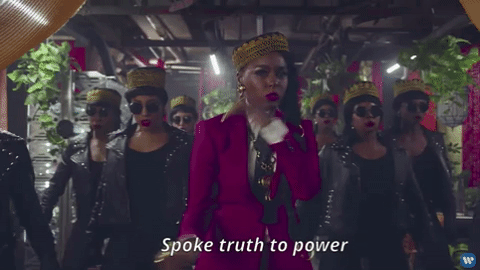Lately I’ve been listening to a lot of Janelle Monae. I will not lie, I did not listen to her much before Dirty Computer, but recently I’ve been considering her work as an intersectional approach to cyberfeminism. Her latest album (as a buildup from her previous ones), uses the concept of Dirty Computer to present Black women (in Monae’s case, specifically young, queer Black women) as “the other.” Her albums (and short film) demonstrate sci-fi as both escape and reality. Android fiction presented side by side with daily struggles of feeling beautiful, experiencing love, and dealing with sexism. Monae calls her film an “emotion picture” and I can think of no better way to describe her work. Emotion Pictures… Bringing the emotion and energy of queer Black women to multimodal mediums that are embraced (rapidly and passionately) by largely Black audiences. Fiction also provides space for Black girls and Black women to explore their emotions and display emotion. Regularly, in both daily life and in fiction, emotional Black women are stereotyped as “mad Black woman,” “crazy,” “violent,” or “faking.” These genres (that is media made by Black women for Black female audiences) let Black women and girls be vulnerable and display emotion (either through character display or reader experience).
In addition to music and film, emotion pictures can also include comics. Sheena C. Howard notes in her piece, “Situating Cyberzone: Black Lesbian Identity in Comics,” the importance of comics to balance between counternarrative and the everyday. Within the article, Howard discusses Cyberzone, a comic book series about a Black superheroine law enforcer named Amanda. While Amanda resists heterosexism in the series, she also still contends with issues young, Black women face such as daily struggles (ie:paying her bills, 411) and queer survival (such as “passing” as straight, 409). Similarly, Monae presents counternarrative (unapologetic #Blackgirlmagic) while also recognizing the struggles and trials of black girlhood at home and in school (in one song she talks about being downrated in school for cutting off her perm).
Likewise in Bingo Love, writer Tee Franklin creates a love story which explores the daily struggle of queer love and coming out late in life. While Franklin outlines the daily struggles vividly (her family rejecting her sexuality, her sadness over losing Mari, her problems in her marriage), she balances these struggles by employing fantasty (showing Mari and Elle in the afterlife together). Sprinkled within these larger narratives, we still see glimpse of daily life for Black women. For example, Elle doing her granddaugher's hair (Zora Gilbert talks more about the importance of this representation here)

One important element of these fictions seems to be a balance between reality, fantasy, and counter-narrative. It’s not enough to present alternatives to reality—Black girl literacies infuse daily life (like doing hair) and daily struggles (such as paying bills, dealing with racism, etc.), alongside empowerment (either through triumph or alternative realities). Multimodal fictions such as these enable readers to see these ideas all coexist through image, writing, sound, and movement. Although they are labeled fiction, they are truth of both the artist and the readers who struggle and exude #Blackgirlmagic. Both can exist simultaneously and must.

